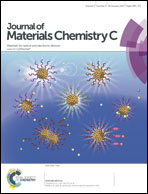Characterization and strong piezoelectric response of an organometallic nonlinear optical crystal: CdHg(SCN)4(C2H6SO)2†
Abstract
Bulk single crystals of CdHg(SCN)4(C2H6SO)2 (CMTD) have been grown by the temperature-lowering method. Refractive index measurements reveal that the refractive index nx along the c axis is much smaller than the ny and nz indices in the ab-plane. The detailed powder second-harmonic generation (SHG) measurements using 1064 nm radiation indicate that the crystal is a phase matchable nonlinear optical material which exhibits a strong SHG effect, 1.2 times that of KTiOPO4. The complete set of dielectric, elastic and piezoelectric constants of CMTD have been measured and the results show that the crystal possesses excellent piezoelectric properties of d36 = 20.40 and d14 = 17.80 pC N−1 (much larger than those of α-SiO2). The crystal exhibits a neutral layered structure consisting of the asymmetric HgS4 tetrahedron and CdN4O2 octahedron which are connected by π-conjugated –S![[double bond, length as m-dash]](https://www.rsc.org/images/entities/char_e001.gif) C
C![[double bond, length as m-dash]](https://www.rsc.org/images/entities/char_e001.gif) N– ligands. The physical properties have been interpreted on the basis of the crystal structure combined with theoretical calculations. The strong piezoelectric response and high optical SHG efficiency make CMTD a promising candidate for both piezoelectric and nonlinear optical applications.
N– ligands. The physical properties have been interpreted on the basis of the crystal structure combined with theoretical calculations. The strong piezoelectric response and high optical SHG efficiency make CMTD a promising candidate for both piezoelectric and nonlinear optical applications.


 Please wait while we load your content...
Please wait while we load your content...